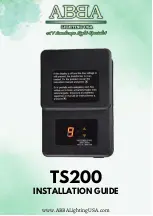Reviews:
No comments
Related manuals for CCT24 Series

TTH300 Series
Brand: ABB Pages: 20

TTH300 Series
Brand: ABB Pages: 24

266 HART Series
Brand: ABB Pages: 76

TTH200
Brand: ABB Pages: 20

ST-101
Brand: AALogic Pages: 17

TS200
Brand: ABBA Pages: 8

345WT
Brand: Badger Meter Pages: 4

X450
Brand: Xblitz Pages: 76

SDR-5900
Brand: Chiayo Pages: 8

UNIVERS U4150
Brand: FTE Pages: 24

MIAMI620
Brand: Blaupunkt Pages: 17

SBD75e Series
Brand: Advantech Pages: 97

W5RS
Brand: M-system Pages: 3

ADCL-200
Brand: Sam Pages: 20

Spotcell 167
Brand: Spotwave Pages: 2

Titan III Combo HD
Brand: Sab Satellite Pages: 43

VRS Switch 1
Brand: Vestamatic Pages: 2

AVM 90
Brand: a-them Pages: 68

















